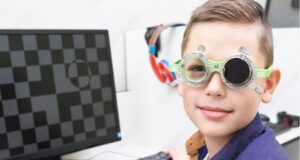Everything about Anisometropic Amblyopia
What is Anisometropic Amblyopia?
Anisometropia, which is a varying refractive error in each eye, causes unilateral Amblyopia, also referred to as Anisometropic Amblyopia (AA). It is the second most typical cause of Amblyopia.
It is a component of refractive Amblyopia, which can be brought on by astigmatism, nearsightedness, or farsightedness.
The issue, primarily observed in young children, is typically identified during wellness (physical) examinations, yearly visits to a pediatrician, or through vision screening tests carried out in primary schools.

Who is at risk of developing Anisometropic Amblyopia?
- Most amblyopia instances are initially identified in children under the age of eight. Adults may occasionally experience late onset of Amblyopia.
- No gender preference is seen, as both men and women are equally impacted.
Noteworthy Research studies say around 70 % of cases of Amblyopia turn out to be Anisometropic Amblyopia. |
What are the causes of Anisometropic Amblyopia?
- Anisometropic Amblyopia is a type of refractive amblyopia brought on by vision discrepancies between the eyes due to conditions like myopia, hyperopia, and astigmatism.
- The severity of anisometropic amblyopia increases with the difference in refractive power between the two eyes.
What are the symptoms of Anisometropic Amblyopia?
The eyes seem normal in Anisometropic Amblyopia. In most cases, the symptoms and signs take time to manifest.
Nevertheless, the following could be the symptoms:
- Issues with depth perception
- Crossed eyes/ Squinting

- Eyes opened wide
- Vision that’s hazy in one or both eyes
- Problems with eye coordination
- Headaches
- Additional vision warning signs and symptoms include poor binocular vision.
How is Anisometropic Amblyopia diagnosed?
The following tests and exams are undertaken to determine whether someone has Anisometropic Amblyopia:
- Physical examination and analysis of medical history
- Checking for signs including wandering eyes, an eye turn, changes in vision between the eyes, and refractive problems.
- Basic eye examination
- Test of corneal light reflex
- sensitivity to contrast
- Visual Acuity
Tests and examinations could be required to identify the presence of any underlying causes.
What are the complications in the case of Anisometropic Amblyopia?
- Inability to read, drive, play sports, or carry out routine duties due to vision issues
- Strabismus development
- Reduced quality of life brought on by the loss of stereoscopic vision, which may also raise the chance of having a car accident or having an industrial accident.
What are the treatments available for Anisometropic Amblyopia?
The refractive defect between the eyes is corrected during treatment. Following are the treatment options available:
- Prescription eyewear intended for daily use (usually the first line of treatment)
- Using cycloplegic refraction glasses all the time

- In some situations, eye patching (for eyes that are not amblyopic)
- The use of drugs like atropine
However, all of the above treatment methods are either troublesome or invasive in nature.
So, what could be the real solution?
The Bynocs Amblyopia Therapy Software – AmblyGo
AmblyGo is an advanced and award-winning eye therapy software capable of treating Anisometropic Amblyopia, or lazy eye, in children and adults.
How does it work?
- Following a discussion with the ophthalmologist, individualized treatment regimens are created.
- By combining a gaming interface and appropriate glasses, Bynocs technology enables the brain to appreciate the visuals from the lazy eye. The visual regions of the brain are the focus of these workouts.
- Adults and kids enjoy the sessions because of the dynamic gaming interface.
- Each session is for 30 minutes, and you are suggested to attend five days a week.
Advantages of AmblyGo
- A straightforward and engaging eye treatment method that requires little equipment – A computer with a steady internet connection and specialized Anaglyph glasses offered by Bynocs is the only equipment required.
- Patients have reported an 80% to 90% improvement in their visual issues after just six weeks of using Bynocs AmblyGo!
- Contact us or drop us an email to know how AmblyGo can help you correct your vision.

